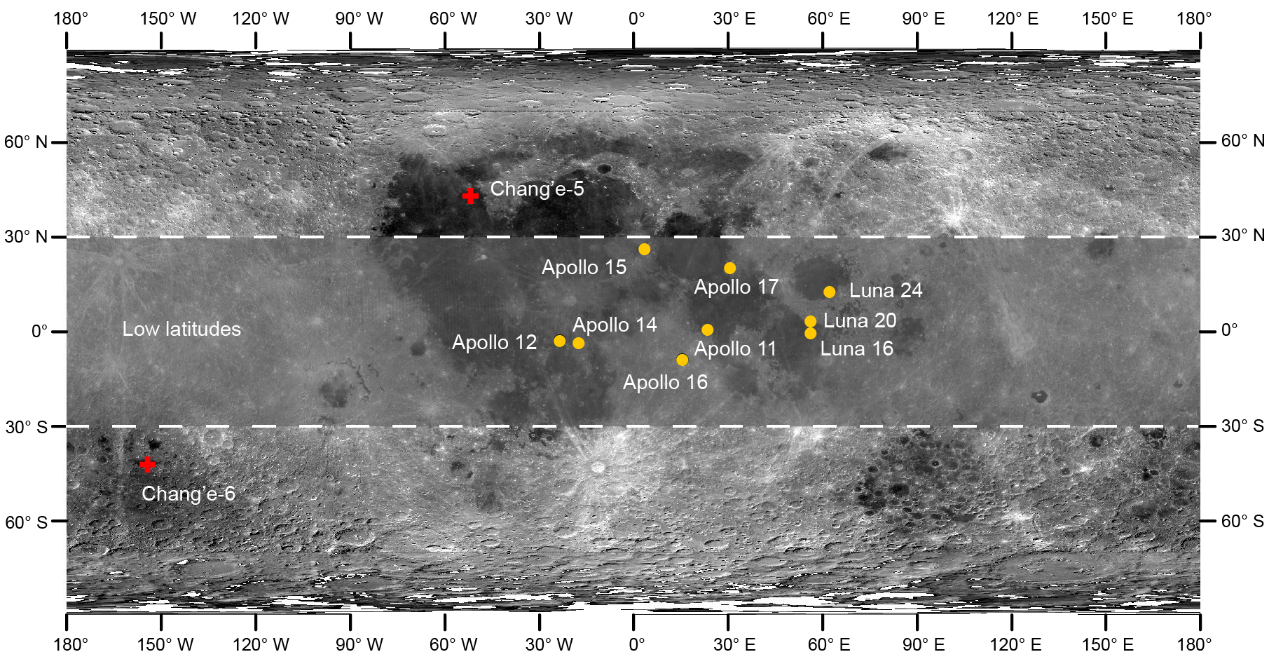The abundance, distribution, and origin of lunar surface water have recently drawn significant scientific interest, owing to its critical role in future space exploration.
A research team from the Institute of Geology and Geophysics of the Chinese Academy of Sciences (IGGCAS) has found that lunar soil samples brought back by China's Chang'e-6 mission (collected from the lunar farside) contain high concentrations of OH/H2O and low deuterium-to-hydrogen (D/H) ratios. These characteristics align with lunar water originating from the solar wind, the team noted.
When compared with samples from China's Chang'e-5 mission (collected from a similar mid-latitude region on the lunar nearside) and NASA's Apollo missions (obtained from lower-latitude areas), the findings indicate that lunar surface water has a global source in the solar wind, and its distribution is mainly controlled by latitude and regolith maturity.
The study was published in Nature Geoscience on November 6.
Lunar surface water serves two critical purposes: It helps trace lunar surface processes, and it represents a potential in-situ resource for future lunar exploration missions.
In early observations, the Moon Mineralogy Mapper (M3) instrument aboard India's Chandrayaan-1 mission used infrared spectral analysis to show that hydroxyl is concentrated primarily at higher latitudes. Missions by NASA's Deep Impact and Cassini confirmed water absorption features at lower latitudes, though these signals were weaker than those at higher latitudes.
However, subsequent quantitative analyses of global M3 data produced conflicting conclusions about the spatial distribution of lunar surface water. Analyses using empirical thermal-correction methods suggested a strong link to latitude-with water content ranging from tens of parts per million (ppm) at low latitudes to approximately 750 ppm at the poles. Analyses relying on a heat-diffusion-based thermal-correction model found no significant variation in water content across the lunar surface.
This discrepancy stems largely from the lack of accurate models to account for uncertainties in thermal emission effects within reflectance spectra. For this reason, the team emphasized that direct laboratory analysis of returned lunar soil samples remains the most reliable way to determine the true abundance and distribution of lunar surface water.
While Apollo and Luna samples provided direct data on lunar water content and origin, all those samples were collected from low-latitude regions on the lunar nearside. Information about the lunar farside was previously limited to remote-sensing observations, leaving gaps in understanding the global distribution and origin of lunar surface water.
China's lunar missions have since addressed this gap. In 2020, the Chang'e-5 mission returned approximately 1,731 grams of lunar soil from a mid-latitude site (43.06°N) in the Northern Oceanus Procellarum Basin. Most recently, the Chang'e-6 mission-marking the first time samples were returned from the lunar farside-brought back about 1,935.3 grams of lunar regolith from a mid-latitude site (41.63°S) in the Apollo Basin, located within the South Pole-Aitken (SPA) Basin.
Together, these samples offer a unique opportunity to assess lunar surface water content and distribution across low-to-mid latitudes, while enabling direct comparisons between the lunar nearside and farside.
In this study, the team used two analytical methods to examine the Chang'e-6 samples. They employed spectral measurements to quantify the bulk OH/H2O content of the soil. Results showed the bulk OH/H2O content was 183 ± 34 ppm.
They also used NanoSIMS depth-profiling to measure hydrogen abundances and D/H ratios at the grain scale. Most grain rims were found to have high hydrogen concentrations (1,000-17,500 ppm) and extremely low δD values-down to −983‰ (±11‰)-indicating a solar wind origin. (Here, δD expresses the deviation of a sample's D/H ratio from a standard reference, reported in per mil (‰).)
Water content in the topmost surfaces of the Chang'e-6 soil grains is comparable to that of Chang'e-5 samples (from the nearside mid-latitudes) but nearly double that of Apollo samples (from lower latitudes). This confirms latitude (which is closely tied to temperature) as a key control on water distribution.
Despite similar water content depth profiles, bulk Chang'e-6 samples showed stronger OH/H2O absorption features and higher regolith maturity than Chang'e-5 samples using infrared reflectance spectra. This identifies regolith maturity as a second critical controlling factor.
Based on these findings, the researchers predict that lunar surface water is likely more abundant in highly mature regolith at higher latitudes. This insight has important implications for planning future lunar resource utilization efforts.
The research was conducted in collaboration with the CAS Shanghai Institute of Technical Physics, the CAS Institute of Geochemistry, and the China Academy of Aerospace Systems and Innovation.
Funding support came from the National Natural Science Foundation of China, the Key Research Program of IGGCAS, and other sources.

Distribution of lunar sampling sites. The Apollo and Luna missions landed at low latitudes, outlined between the two dashed white lines. In contrast, the Chang'e-5 and Chang'e-6 missions landed at mid-latitudes. (Image by LIN Honglei)

Depth profiles of the water content in lunar soil particles from different latitudes. (Image by TIAN Hengci)






